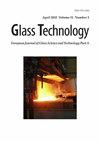IOT Monitoring Systems in Fish Farming Case Study:” University of Rwanda Fish Farming and Research Station (Ur-FFRs)”
IF 0.5
4区 材料科学
Q4 MATERIALS SCIENCE, CERAMICS
Glass Technology-European Journal of Glass Science and Technology Part a
Pub Date : 2023-08-13
DOI:10.47672/ejt.1559
引用次数: 0
Abstract
Purpose: Fish farming refers to the farming of aquatic organisms such as fish. It involves cultivating freshwater and saltwater populations under controlled conditions. The purpose of this research is to provide a solution to the fish farmer by developing an application that would be easy to monitor water quality during the fish farming process. This will help the fish farmers to intervene timely, and therefore increase their production. The design and implementation of IoT Monitoring Systems in Fish farming helps to observe the farming system remotely by using different sensors for the water parameters. The research focused on developing a system for real time monitoring of culture tank water quality as a proof of concept and testing the basic functionalities of the system. Methodology: The research adopted the Rapid application methodology, which was deemed best due to its iterative approach to applications development as it also delivers systems faster at a lower cost in time-constrained projects. This methodology was suitable for our research given the time constraints in developing the application. Secondary data was used to determine the water quality aspects that require monitoring. Interviewing the operators of the culture tank also provided information on what should be incorporated in the model. by developing an application that would be easy to monitor water quality during the fish farming process. The application dashboard is the graphical user interface that the users shall use to interact with application components. Findings: This research proposes a solution, which is a real-time culture tank (hatchery) water quality-monitoring model, which utilizes a web application that shall be adopted by the staff of the University of Rwanda Fish Farming and Research Station and farmers. The model utilizes the IoT concept, which enables information gathering about water quality through the corresponding sensors. The status of the water quality aspects shall then be relayed on a real-time basis through a cloud platform. The farmer can then act based on the information provided, or the model can act on the farmer's behalf based on predetermined actions. The model's data can be extracted and analysed in a variety of different ways. Recommendations: This research contributed in developing a technological solution for real time monitoring water quality aspects of culture tank (hatchery) that can be adopted by fish farmers in Rwasave Fish Farming and Research Station by providing them with real time data whenever they are within or away from the culture tank (hatchery) site. This helps to eliminate or minimize the risk of losing fish and wastages due late interventions.it was validated by supervisors of the project.鱼类养殖中的物联网监测系统案例研究:“卢旺达大学鱼类养殖和研究站(Ur-FFRs)”
用途:养鱼是指鱼类等水生生物的养殖。它包括在控制条件下培育淡水和咸水种群。本研究的目的是通过开发一种在养鱼过程中易于监测水质的应用程序,为养鱼者提供解决方案。这将有助于养鱼户及时干预,从而提高产量。在养鱼中设计和实施物联网监测系统有助于通过使用不同的水参数传感器远程观察养殖系统。研究的重点是开发一个实时监测培养水箱水质的系统,作为概念验证和测试系统的基本功能。方法:该研究采用了快速应用程序方法,该方法被认为是最好的,因为它是应用程序开发的迭代方法,因为它还可以在时间有限的项目中以较低的成本更快地交付系统。考虑到开发应用程序的时间限制,这种方法适合我们的研究。二级数据用于确定需要监测的水质方面。对培养罐操作人员的采访也提供了关于模型中应纳入什么的信息。通过开发一种在养鱼过程中易于监测水质的应用程序。应用程序仪表板是用户用来与应用程序组件交互的图形用户界面。研究结果:本研究提出了一种解决方案,即利用web应用程序开发的实时培养池(孵化场)水质监测模型,供卢旺达大学养鱼研究站工作人员和养殖户使用。该模型利用了物联网概念,通过相应的传感器收集有关水质的信息。然后通过云平台实时传递水质方面的状态。然后,农民可以根据提供的信息采取行动,或者模型可以根据预定的行动代表农民采取行动。该模型的数据可以用各种不同的方法提取和分析。建议:本研究有助于开发一种实时监测养殖池(孵化场)水质方面的技术解决方案,可由Rwasave鱼类养殖和研究站的养鱼户采用,无论他们在养殖池(孵化场)内或外,都可以为他们提供实时数据。这有助于消除或最大限度地减少因后期干预而损失鱼类和浪费的风险。该方案得到了项目主管的验证。
本文章由计算机程序翻译,如有差异,请以英文原文为准。
求助全文
约1分钟内获得全文
求助全文
来源期刊
CiteScore
0.30
自引率
0.00%
发文量
0
审稿时长
>12 weeks
期刊介绍:
The Journal of the Society of Glass Technology was published between 1917 and 1959. There were four or six issues per year depending on economic circumstances of the Society and the country. Each issue contains Proceedings, Transactions, Abstracts, News and Reviews, and Advertisements, all thesesections were numbered separately. The bound volumes collected these pages into separate sections, dropping the adverts. There is a list of Council members and Officers of the Society and earlier volumes also had lists of personal and company members.
JSGT was divided into Part A Glass Technology and Part B Physics and Chemistry of Glasses in 1960.

 求助内容:
求助内容: 应助结果提醒方式:
应助结果提醒方式:


